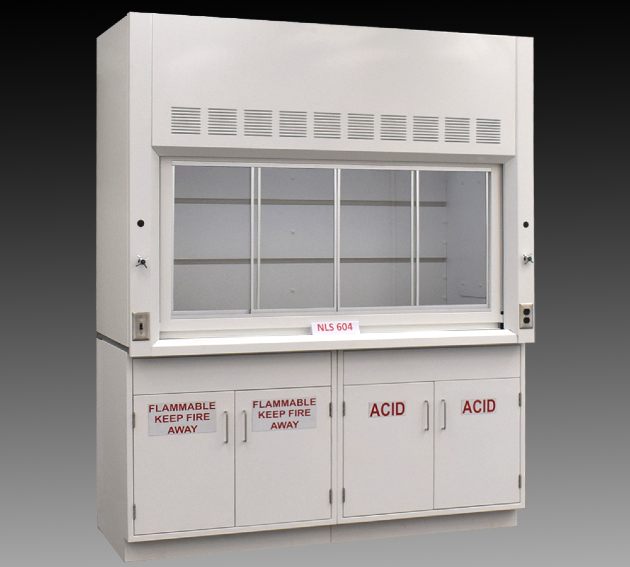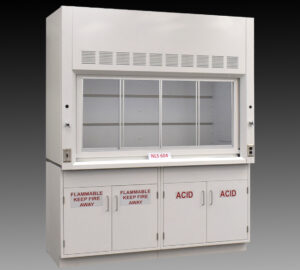Laboratories that handle hazardous chemicals must do more than store them neatly; they must store them safely and in compliance with regulatory standards. Two common storage solutions—flammable liquid cabinets and acid (or corrosive) storage cabinets—are often confused. They serve very different purposes and are not interchangeable.
Whether you’re selecting storage for an existing lab or setting up a new one, we’ll explain the key differences between cabinet types, when each is required, and how Fisher American’s storage solutions can enhance safety and workflow efficiency.
What Is a Flammable Storage Cabinet?
Flammable storage cabinets are engineered to safely store flammable and combustible liquids, substances that can ignite at relatively low temperatures. These cabinets are typically labeled to indicate their use.
Key Features:
- Construction: Made from double-walled steel with a 1.5″ air gap for fire resistance.
- Doors: Manual or self-closing doors, depending on code requirements.
- Labeling: Must be marked “Flammable – Keep Fire Away.”
- Venting: Not required by OSHA, but local fire codes may vary.
Regulatory Requirements:
- Must comply with OSHA 29 CFR 1910.106 and NFPA 30.
- Limits apply to the amount of flammable material that can be stored outside a cabinet.
Common Flammable Chemicals:
- Acetone
- Ethanol
- Methanol
- Isopropanol
- Toluene
What Is an Acid or Corrosive Storage Cabinet?
Acid storage cabinets are designed to contain corrosive chemicals, including strong acids and bases. These substances can deteriorate standard materials and produce hazardous fumes if not stored properly.
Key Features:
- Construction: Made from corrosion-resistant materials such as polyethylene, epoxy-coated steel, or phenolic resin.
- Ventilation: Often vented to prevent vapor buildup.
- Labeling: Marked as “Corrosive” or “Acid.”
Regulatory Requirements:
- While OSHA doesn’t mandate acid-specific cabinets, ANSI/NFPA guidelines and good laboratory practice strongly encourage separate, compatible storage.
- Chemical compatibility is critical. Mixing acids and bases, for example, can cause dangerous reactions.
Common Corrosive Chemicals:
- Hydrochloric acid
- Sulfuric acid
- Nitric acid
- Sodium hydroxide
- Acetic acid
Why the Distinction Matters
Storing the wrong chemical in the wrong cabinet poses serious risks:
- Corrosives in flammable cabinets can cause the steel to rust, weakening the cabinet’s fire resistance and possibly releasing toxic fumes.
- Flammables in acid cabinets lack proper fire protection, potentially leading to uncontrolled combustion in the event of a fire.
- Improper storage may violate local codes, OSHA regulations, or institutional policies, exposing your lab to compliance and safety risks.
The takeaway: These cabinets are not interchangeable.
When Does a Lab Need Both?
If your lab handles both flammable solvents and corrosive reagents, you’ll need separate storage solutions for each. Some labs opt for two freestanding cabinets, but many take advantage of integrated base cabinet options built into fume hoods.
Integrated Storage with Fisher American
At Fisher American, many fume hood models offer built-in flammable and acid storage cabinets beneath the work surface. These integrated solutions help:
- Keep hazardous chemicals close to the point of use
- Save valuable floor space
- Ensure code-compliant separation between incompatible substances
Integrated storage also makes it easier to manage inventory and maintain clear labeling protocols, an often-overlooked part of lab safety.
Conclusion
Flammable and acid storage cabinets are essential for maintaining a safe and compliant lab environment. They’re built for different hazards, follow different design standards, and serve different purposes. Choosing the right one, or both, depends on the chemicals you use and how your lab is organized.
If you’re outfitting a new lab or rethinking your chemical storage strategy, explore fume hoods from Fisher American that include flammable and acid storage. It’s a smart way to keep safety and functionality aligned, right where it matters most.



